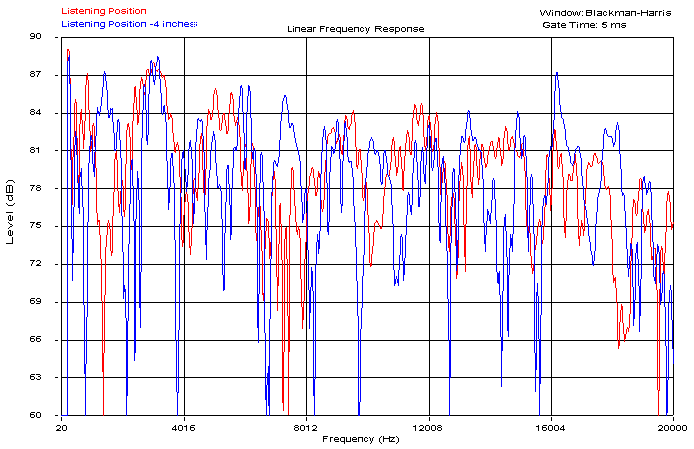Panicos K said:Yes it is possible.That is why I sometimes use that forbidden "S" word🙂
Yes, SYNERGY is very important. 😀 😀 😀 😀 😀
Saying that, I don't believe in using equipment or cables to hide the shortcomings of other parts in a system, if every part is operating optimally you should get the best results.
Panicos K said:You are not trying to start a new "war"about connectors "sound"are you? 😀
yes, lol!! eliminate all connectors! no more DIN, HDMI, RCA, XLR, TRS, SVHS, MINI, SPDIF, SCSI, USB, FIREWIRE, ADB, IRS, CIA, CSIS, FBI, IRA, WWF, WTA, NRA...... think of how a guitar's sound degrades as it goes through more and more pedals, even when they are all off. plugging right inTo the amp gives the most dynamic, open sound. one pedal or two wont make much difference, but plug in a chain of ten, and the signal gets weakened audibly. so, there IS an effect of connectors, from a scientific standpoint, i guess, but it is very negligible, imo.
i don't think connectors have very much effect. i certainly think good non-corrosive metal which is a good conductor and a tight fit are good enough to be transparent. the thickness of that little bit of metal would only change the sound if it was a REALLY lousy conductor, imo. like super rusted or heavily otherwisely oxidized. that can dull the sound. i've heard it happen. some studios change all their cables every few years, i've heard.
but, i figger why bother with them at all if you can avoid it for less money.
rdf said:This thread is the real reason the forum upgrade is delayed, isn't it? Fess up.
No, it's the Blowtorch. More traffic in that one thread than most entire forums.
panomaniac said:
I does seem difficult.
Here is a good article about interconnects and the complex problems they may cause or cure.
This is a least an engineering approach, like it our not.
http://www.soundstage.com/articles/pete01.htm
(From Cuibonos mother load cable bibliography)
Thanks for the link, fascinating reading.
I have just been trying to optimise my system grounding and this just goes to show the interactive nature of this with cables.
Off topic I know, but, I have just obtained significant improvements by reducing the measureable AC leakage currents on my equipment chassis by measuring the result of switching transformer primary windings with reference to phase and neutral of the mains. This is not so easy when one component has 4 transformers... (one of them being reversed compared to the remaining 3).
An explanation as good as any other - maybe even better:
http://www.ethanwiner.com/believe.html

Now, there is obviously some "conflict" of interest here - after all, he produces acoustic treatment.
But his ideas are valid - using the deq to flatten the FR in my room, I know from experience that moving the measuring mike just inches can produce vastly different equalization results. We are talking up to 6dB difference.
http://www.ethanwiner.com/believe.html

More recently I examined the same data over the entire audible range, and that graph is shown below in Figure 2. The two responses are so totally different you'd never guess this is even the same room and loudspeakers!
The cause of these large response differences is comb filtering. Peaks and deep nulls occur at predictable quarter-wavelength distances, and at higher frequencies it takes very little distance to go from a peak to a null. For example, at 7 KHz a quarter wavelength is less than half an inch! At these higher frequencies, reflections from a nearby coffee table or even a leather seat back can be significant. Because of comb filtering, moving even a tiny distance changes the response by a very large amount at mid and high frequencies. Especially in small rooms having no acoustic treatment at the first reflection points. The response at any given cubic inch location in a room is the sum of the direct sound from the speakers plus many competing reflections arriving from many different directions. So unless you strap yourself into a chair and clamp your head in a vise, there's no way the sound will not change dramatically when you move even one inch.
Now, there is obviously some "conflict" of interest here - after all, he produces acoustic treatment.
But his ideas are valid - using the deq to flatten the FR in my room, I know from experience that moving the measuring mike just inches can produce vastly different equalization results. We are talking up to 6dB difference.
No, it's nonsensical. Winer's explanation requires we hear dramatic system changes every time we reach for the remote. That we don't is due to the fact that our ears hear the comb filtering effects - really frequency domain manifestations of delayed reflections - for what they are: characteristics of the room. This should be obvious.
whilst I am not a believer in cables, this explanation has always seemed strained to me. I mean our ears adjust to minor differences all the time, else the person talking to us as they walk thru the room will be a 'different person' progressively.
sorry, too simplistic for me.
sorry, too simplistic for me.
terry j said:whilst I am not a believer in cables, this explanation has always seemed strained to me. I mean our ears adjust to minor differences all the time, else the person talking to us as they walk thru the room will be a 'different person' progressively.
sorry, too simplistic for me.
I find this curious, too!
Try a single pure tone, say 5KHz, and then walk around the room: Outrageous comb filtering all over the place!
How do the ears cope with this (and they do!) with music signals?
cliff said:
I find this curious, too!
Try a single pure tone, say 5KHz, and then walk around the room: Outrageous comb filtering all over the place!
How do the ears cope with this (and they do!) with music signals?
That is the perfect "S" between ears and brain.🙂
cliff said:
I find this curious, too!
Try a single pure tone, say 5KHz, and then walk around the room: Outrageous comb filtering all over the place!
How do the ears cope with this (and they do!) with music signals?
The ears don't. It's the brain, the organ that audiophiles never seem to account for...
SY said:
The ears don't. It's the brain, the organ that audiophiles never seem to account for...
While for the hardcore engineer when his eyes see some measurements on the screen and his brain understands what his eyes see,it is enough to conclude that it sounds good or bad?I wonder how it is to hear without ears.I suspect it must be like seeing without eyes.The brain will do the rest........as always.
I'm not sure what a "hard core engineer" is, but chances are he also has a brain. Understanding of perceptual issues isn't so much engineering as applied psychology and neurology. After all, what is "subjective" other than how a brain processes the input?
To me,a hard core engineer is the oposite of what an engineer calls "audiophile"🙂 As for the rest,I couldn't agree more.In fact,it is that input that the brain processes that I'm talking about.My brain receives that input from my ears.Yours?Finally,I'm sure you don't mean I don't have brain,it must be that English of mine again.........
SY said:
The ears don't. It's the brain, the organ that audiophiles never seem to account for...
Booooo! The context made it obvious the meaning intended the ear/brain system. Ears alone aren't capable of interpretation. Winer is in fact guilty of that charge, not those challenging such sophomoric gaffs.
Attachments
Panicos K said:...I'm sure you don't mean I don't have brain.........
Would that be a "straw man" argument?

Robert F said:Thanks for the link, fascinating reading.
I have just been trying to optimise my system grounding and this just goes to show the interactive nature of this with cables.
You're welcome. I thought it was a good read, too. Lot's of info there, plenty to digest. Reducing those noise loops is important! It is something was should all work on.
SY said:The ears don't. It's the brain, the organ that audiophiles never seem to account for...
Strange, my thought was that "audiophiles" do account for the brain's part in hearing.
Panicos K said:
While for the hardcore engineer when his eyes see some measurements on the screen and his brain understands what his eyes see,it is enough to conclude that it sounds good or bad?I wonder how it is to hear without ears.I suspect it must be like seeing without eyes.The brain will do the rest........as always.
i had to mix with earplugs in once (i had a kick drum in the headphones way too loud incident that temporarily damaged my hearing. it was bad! took months for my hearing to come back. listening was PAINFUL).
An externally hosted image should be here but it was not working when we last tested it.
i mixed twelve songs, trusting mostly on my memory of how to get good sounds for certain instruments, ie. what compressor to use on the vocals, or drum overheads, and the best ratio, attack, decay, what i could safely EQ out of a given channel to clear away mud, and of course, optimum levels at each gain stage, etc. i could still hear the mix, but through 50 cent -29db foam earplugs which i wore 24/7.
suffice it to say that everyone was amazed at how good the mix was, and not 'considering', but 'despite'. especially me. i don't know if i could have done better with my ears alone. i think, when i'm mixing more by ear, i can more easily bury or over-pronounce certain tracks, depending on what i'm listening for (less of a problem when i'm mixing alone, and there aren't twelve confilcting opinions 🙂 ).
when i did this 'deaf mix', however, i WAS relying on what my ears taught me while they were acute, and what i learned through years of trial and error of hearing my mixes on various systems. i couldn't have done it on an unfamiliar board with unfamiliar monitors and outboard gear.
i wouldn't try and master without ears, though. that would be bad.
the ear/brain discussion is good. those 'extreme' differences from moving your head one inch are not measured with ears, either. they are measured with microphones. when will people learn that microphones are not ears? i'd bet different microphones with different pickup patterns would give different results for that same test. and i'd bet that a microphone doesn't know where the sound is coming from, and where the walls and floor are, and whether the room is live or dead sounding. the brain knows, and adjusts accordingly what the ears 'see'.
also, we have two ears, not one like a microphone. the signals from both ears are compared in the brain.
in a room where there are two spots with radically different frequency reinforcement/cancellation zones that were large enough to put BOTH ears at once into, the listener would EASILY hear the difference. however, moving your head a half inch to the side a doesn't change your spectral perception much, unless you're near a weird room hot spot. some tests that 'prove' things are just silly, lol.
Nobody has mentioned changes in barometric pressure & temperature yet.... The properties of "air" are nominal at best.
Its also interesting that the argument about small changes in ear or microphone position be criticised. There is plenty of evidence that careful positioning of the speaker within a room can have a significant effect on the perceived sound quality.
Ed
Its also interesting that the argument about small changes in ear or microphone position be criticised. There is plenty of evidence that careful positioning of the speaker within a room can have a significant effect on the perceived sound quality.
Ed
- Status
- Not open for further replies.
- Home
- Design & Build
- Parts
- I don't believe cables make a difference, any input?

